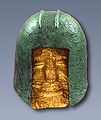- Illyrian type helmet
-
 Greek "Illyrian type" bronze helmet from Argolis (6th–5th centuries BC).
Greek "Illyrian type" bronze helmet from Argolis (6th–5th centuries BC).
The "Illyrian" or "Greco-Illyrian" type helmet is an archaeological term that describes a style of bronze helmet, which in its later variations covered the entire head and neck, and was open-faced in all of its subsequent forms.[1] Its earliest styles were first developed in Ancient Greece, specifically in the Peloponnese, during the 8th and 7th centuries BC (700-640 BC).[2][3] Accurate representations on Corinthian vases are sufficient to indicate that the "Illyrian" type helmet was developed before 600 BC.[4] The helmet was misleadingly named as an "Illyrian" type due to a large number of early finds coming from Illyria.[5]
Contents
Archaeology
According to the archaeological evidence, the "Illyrian" type helmet evolved from the Kegelhelm (or Kegel type) of the Archaic Period found in Argos.[6] The earliest "Illyrian" type helmets were developed in a workshop located in the northwestern Peloponnese (possibly Olympia), although the first Type II "Illyrian" helmets were created in Corinthian workshops.[2] The first Type III helmets were created in workshops situated somewhere on the Illyrian coast of the Adriatic.[7] The "Illyrian" type helmet did not obstruct the wearer's critical senses of vision though the first two varieties hampered hearing. There were four types of these helmets and all were open faced.
- Type I (ca. 700 BC-640 BC) left the neck unprotected and hampered hearing.
- Type II (ca. 600 BC) offered neck protection and again hampered hearing.
- Type III (ca. 550 BC) offered neck protection and allowed better hearing.
- Type IV (ca. 500 BC) was similar to Type III but hearing was not impaired at all.
The Illyrian type helmet was used by the Ancient Greeks,[8] Etruscans,[9] Scythians,[10] and became popular with the Illyrians who later adopted it.[8][11] A variety of the helm had also spread to Italy based on its appearance on ivory reliefs and on a silver bowl at the "Bernardini" tomb at Praeneste.[4] The helmet became obsolete in most parts of Greece in the early 5th century BC. Its use in Illyria had ended by the 4th century BC.[12]
Gallery
-
Types of Ancient Greek helmets; top line, third from the left: "Illyrian type" helpet. Antikensammlung in Altes Museum, Berlin.
-
"Illyrian type" helmet with funeral mask, cemetery of Sindos, c. 520 BC, Archaeological Museum of Thessaloniki.
-
"Illyrian type" helmet from Budva, Montenegro c. 4th century BC.
See also
- Corinthian helmet
- Thracian helmet
- Attic helmet
- Boeotian helmet
References
- ^ Connolly 1998, p. 60.
- ^ a b Treister 1996, pp. 59–62.
- ^ Wilkes 1995, p. 108; Pearce et al. Vidale, p. 242.
- ^ a b Snodgrass 1964, p. 20.
- ^ Snodgrass 1999, pp. 76, 95; Sekunda 1998, p. 53: "Figure D2, based on a Lakonian warrior statuette from Dodona, wears a helmet of the Illyrian type, so-named because a large number of early finds came from Illyria. However, it is now clear that it was also extremely popular in the Peloponnese, which is the most probable area of origin."
- ^ Connolly 1998, p. 60.
- ^ Treister 1996, p. 65: "The earliest variants of type 3 of the Illyrian helmet, dating primarily to the second half of the 6th century B.C., belong to the production of the workshops situated somewhere on the Illyrian coast of the Adriatic."
- ^ a b Snodgrass 1999, p. 52: "Another common form, superficially similar to the 'Insular', is the so-called 'Illyrian' helmet, in fact a purely Greek type which perhaps originated somewhere in the Peloponnese in the earlier seventh century, and only centuries later found its way to Illyria and other barbarian lands."
- ^ Zabern 1983, p. 165.
- ^ Cernenko, McBride & Gorelik 1983, p. 45.
- ^ Snodgrass 1999, p. 76.
- ^ Wilkes 1995, p. 241.
Sources
- Connolly, Peter (1998). Greece and Rome at War. Greenhill Books. ISBN 185367303X. http://books.google.com/books?id=k_LbAAAAMAAJ.
- Cernenko, E. V.; McBride, Angus; Gorelik, M. V. (1983). Scythians 700-300 B.C. Osprey Publishing. ISBN 0850454786. http://books.google.com/books?id=ozA8d9AFiMgC.
- Pearce, Mark; Tosi, Maurizio; Moravetti, Alberto; Milliken, Sarah; Vidale, Massimo (1998). Papers from the EAA Third Annual Meeting at Ravenna 1997: Pre- and Protohistory. Archaeopress. ISBN 0860548945. http://books.google.com/books?id=XDErAQAAIAAJ.
- Sekunda, Nick (1998). The Spartan Army. Osprey Publishing. ISBN 1855326590. http://books.google.com/books?id=htg5e1-vU64C.
- Snodgrass, Anthony M. (1999). Arms and Armor of the Greeks. Johns Hopkins University Press. ISBN 0801860733. http://books.google.com/books?id=3aHfAAAAMAAJ.
- Snodgrass, Anthony M. (1964). Early Greek Armour and Weapons: From the End of the Bronze Age to 600 B.C. University Press. http://books.google.com/books?id=nFkIAQAAIAAJ.
- Treister, Michail Yu. (1996). The Role of Metals in Ancient Greek History. E. J. BRILL. ISBN 9004104739. http://books.google.com/books?id=dcTexDa4I0kC.
- Wilkes, John J. (1995). The Illyrians. Blackwell Publishing Ltd. ISBN 0631198075. http://books.google.com/books?id=4Nv6SPRKqs8C&dq=isbn:0631198075.
- Zabern, Philipp von (1983). Etruscan Votive Bronzes: Geometric, Orientalizing, Archaic, Volume 2. Philipp von Zabern. ISBN 380530546X. http://books.google.com/books?ei=MKgDTd20B4K78gb_zYDYAw.
External links
 Media related to Category:Ancient helmets at Wikimedia Commons
Media related to Category:Ancient helmets at Wikimedia Commons
Illyrians-related topics Culture Tages · Daunian pottery · Messapian pottery · Peucetii pottery · Devollite pottery · Gradistë belt-plate · Trebeništa masks · Vače situla · Vače belt-plate · Soleto Map · Monte Saraceno woman · Illyrian religion · Illyrian clothing · Illyrian coinage · Illyrian fibulae · Spectacle brooch · Daunian stele · ]
]Warfare Illyrian Wars · Alexander's Balkan campaign · Great Illyrian Revolt · Sica · Sibyna · Illyrian type helmet · Enchele kingdom · LembosLanguage Cities Categories:- Warfare of the Ancient era
- Ancient Greek helmets
- Ancient Peloponnese
- Ancient Corinth
- Archaic Greece
- Illyrian warfare
Wikimedia Foundation. 2010.




